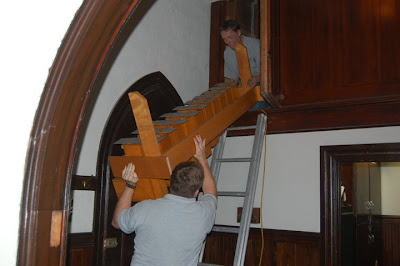Yesterday the vintage 1930 Estey Harp unit in the organ at the First Presbyterian Church of Bloomsburg, PA was removed by a team from Patrick J. Murphy and Associates to be brought to their facilities for a much needed restoration. It should be reinstalled sometime in December, just in time for Christmas!
Here are some pictures of the removal of the old unit.
 |
| First, the 4 rows of mallets were removed. |
The first order of business was to remove the mallets. There are 49 mallets divided into 4 rows. These mallets strike tuned plates via pneumatic contacts. From up close, the sound resembles a xylophone, but when the harp is in a chamber and the listener is out in the church, the affect is very convincing and actually sounds like a harp! Part of this is due to the wooden resonator pipes. These large, square, stopped, wooden pipes are attached to the unit, one per note. They are lined up against the tuned plates and help the sound to resonate (hence their name). This contributes to a realistic harp sound. Many organ harp units use metal resonators, however, wooden resonators create a warmer, more convincing affect.
After the four big, dusty rows of mallets were removed, the crew had to remove the four rows of tuned plates and resonators, this was the tricky part! The rows of plates and resonators are much larger and heavier than the mallets!
 |
| Row # 1 |
 |
| Row # 2 |
 |
| Row # 3 |
|
 |
| And finally, row #5, the largest component of the harp. |
 |
| Close up on resonators |
 |
| Close up on tuned plates |






